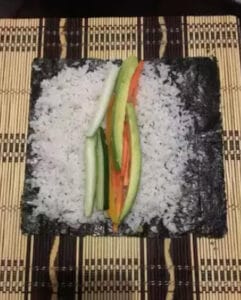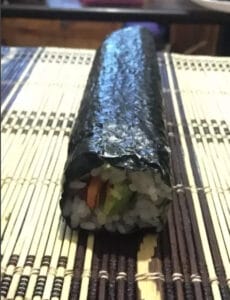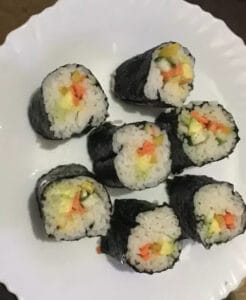As the Sous Chef at Food And Meal, I’ve spent over a decade perfecting my recipes for mouthwatering barbecue. But lately, I’ve found myself craving lighter fare. After one too many pulled pork sandwiches, I decided it was time to give my taste buds a break.
That’s when I discovered vegetable maki rolls – a lighter, fresher take on sushi that still delivers on flavor. As I experimented with different fillings, I fell in love with the simplicity of fresh avocado, cucumber and carrot paired with nutty brown rice and the subtle ocean taste of nori. They were so fresh and vibrant, I could practically feel my body thanking me.
Beyond being delicious, I loved learning about the history and tradition behind maki sushi rolls. The combination of rice, vegetables and nori dates back centuries in Japanese culture. And yet, each chef puts their own creative spin on the classic combo. I may be known for southern flavors, but I couldn’t resist trying my hand at some delicate Japanese cuisine.
The best part is that vegetable maki rolls make for a perfect healthy lunch or light dinner. They’re easy enough to assemble that even my kids can help out. And they’re just as good the next day, so I keep extras on hand for quick meals and snacks. I never get bored, since there are endless filling combinations to try out.
I’ll always have a soft spot in my heart for smoky, tender barbecue. But my newest passion is experimenting with lighter, brighter flavors like these vegetable maki rolls. They make me feel rejuvenated and excited about cooking again. I can’t wait to keep dreaming up new maki masterpieces!
What is vegetable maki rolls?
Vegetable maki, a delightful Japanese culinary creation, is a testament to the versatility and artistry of sushi without the need for seafood. These bite-sized pieces of joy are crafted with seasoned rice, an assortment of fresh vegetables, and sometimes even tantalizing additions like shiitake mushrooms, all snugly rolled in a sheet of roasted seaweed known as nori.
The experience of savoring vegetable maki roll is akin to a symphony of flavors and textures playing harmoniously on the palate. The subtle sweetness of the rice, seasoned with a hint of vinegar, sugar, and salt, complements the crispness of fresh vegetables like cucumber, avocado, and bell peppers. The toasted sesame seeds sprinkled within add a nutty crunch that contrasts beautifully with the softness of the rice.
As someone who relishes the freshness and simplicity of vegetarian cuisine, I find vegetable maki to be a refreshing alternative to the more common fish-laden sushi rolls. It’s a dish that doesn’t just cater to vegetarians but also offers a guilt-free indulgence for those looking to enjoy sushi without venturing into the realm of raw fish. The fact that it’s often healthier, lower in calories, and packed with nutrients only adds to its appeal.
The process of making vegetable maki rolls can be a therapeutic endeavor, requiring a gentle touch and a bit of practice to perfect the rolling technique. There’s something incredibly satisfying about laying out the ingredients, rolling them tightly with a bamboo mat, and then slicing the sushi roll into perfect rounds that reveal a colorful cross-section of nature’s bounty.
In my opinion, vegetable maki is not just food; it’s an edible art form. It’s a celebration of natural flavors that doesn’t try to mimic meat or fish but instead stands proudly on its own merits. Whether enjoyed in the comfort of home or as a quick, healthy option from a supermarket or sushi restaurant, vegetable maki is a testament to the beauty of plant-based eating and the endless possibilities it presents.
Best Vegetable Maki Roll Recipes
Vegetable Maki is one of the most popular types of sushi in Japan. It is made with brown rice, shiitake mushrooms, cucumber, avocado, and carrot. You can also add a dipping sauce such as miso lemon. Vegetable maki is best served fresh, so make sure to make it the day before you plan to eat it. It will taste better. Here are some tips for making this type of sushi.
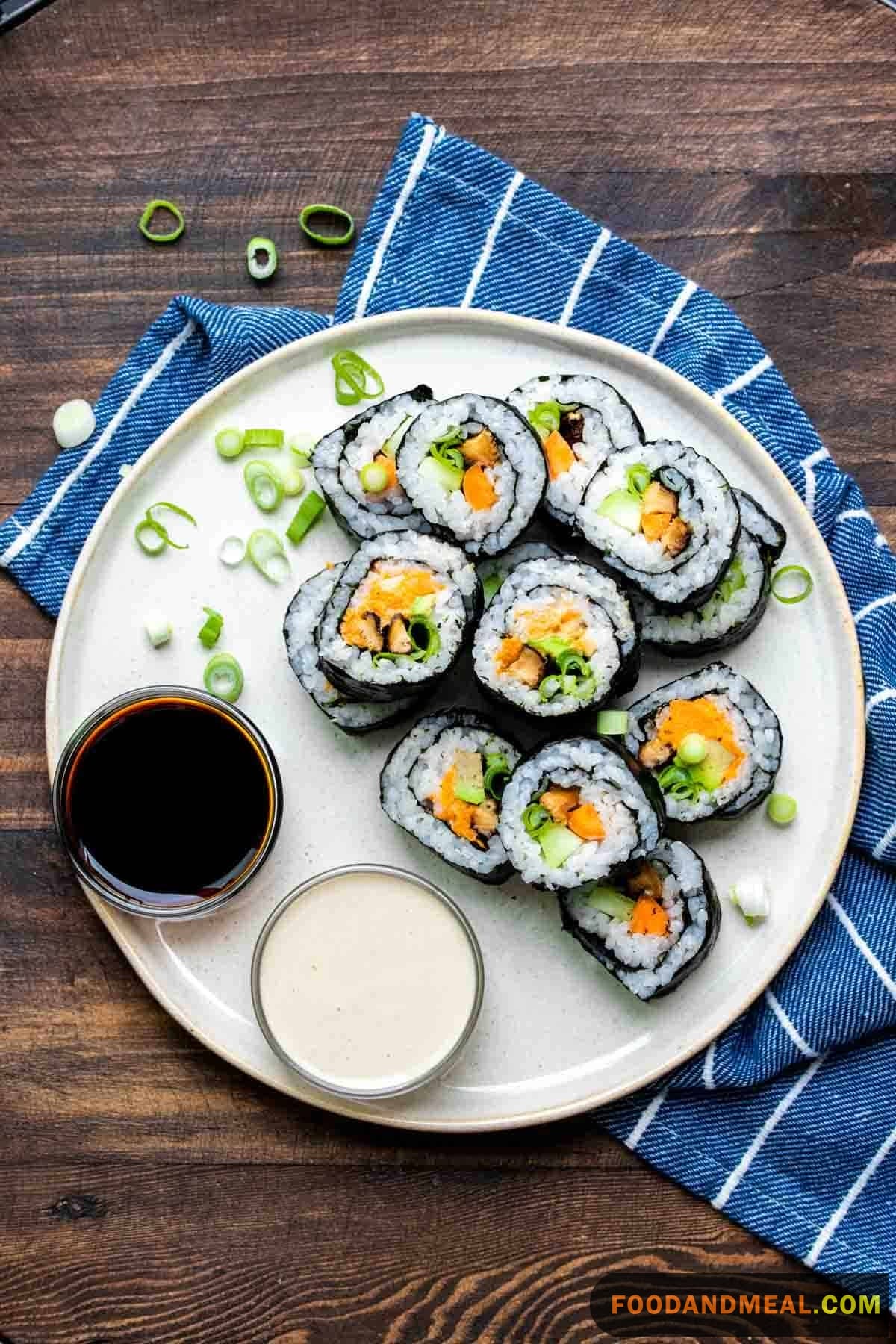
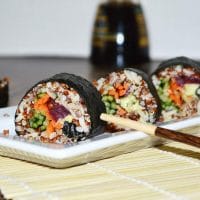
Vegetable Maki
Equipment
Ingredients
- 1 package nori roasted seaweed sheets
- 2 carrots peeled and sliced lengthwise into narrow strips
- 1 cucumber pitted and sliced lengthwise into narrow strips
- 1 avocado halved, pitted and cut into narrow strips
- Cream cheese block form, cut into narrow strips
- Soy sauce
- Wasabi for serving
- Sesame seeds
Instructions
- Follow the steps to making sushi up to step 3.
- For the filling, place a carrot strip, cucumber strip, cream cheese, and avocado across the rice bed.

- Proceed with the rest of the steps in making sushi.

- Garnish each piece with sesame seeds.

- Serve with soy sauce for dipping and wasabi.

Video
Notes
Nutrition
© Food And Meal
This website provides approximate nutrition information for convenience and as a courtesy only. Nutrition data is gathered primarily from the Spoonacular Database, whenever available, or otherwise other online calculators.
Alternative Method: Veggie Maki Salad Bowl
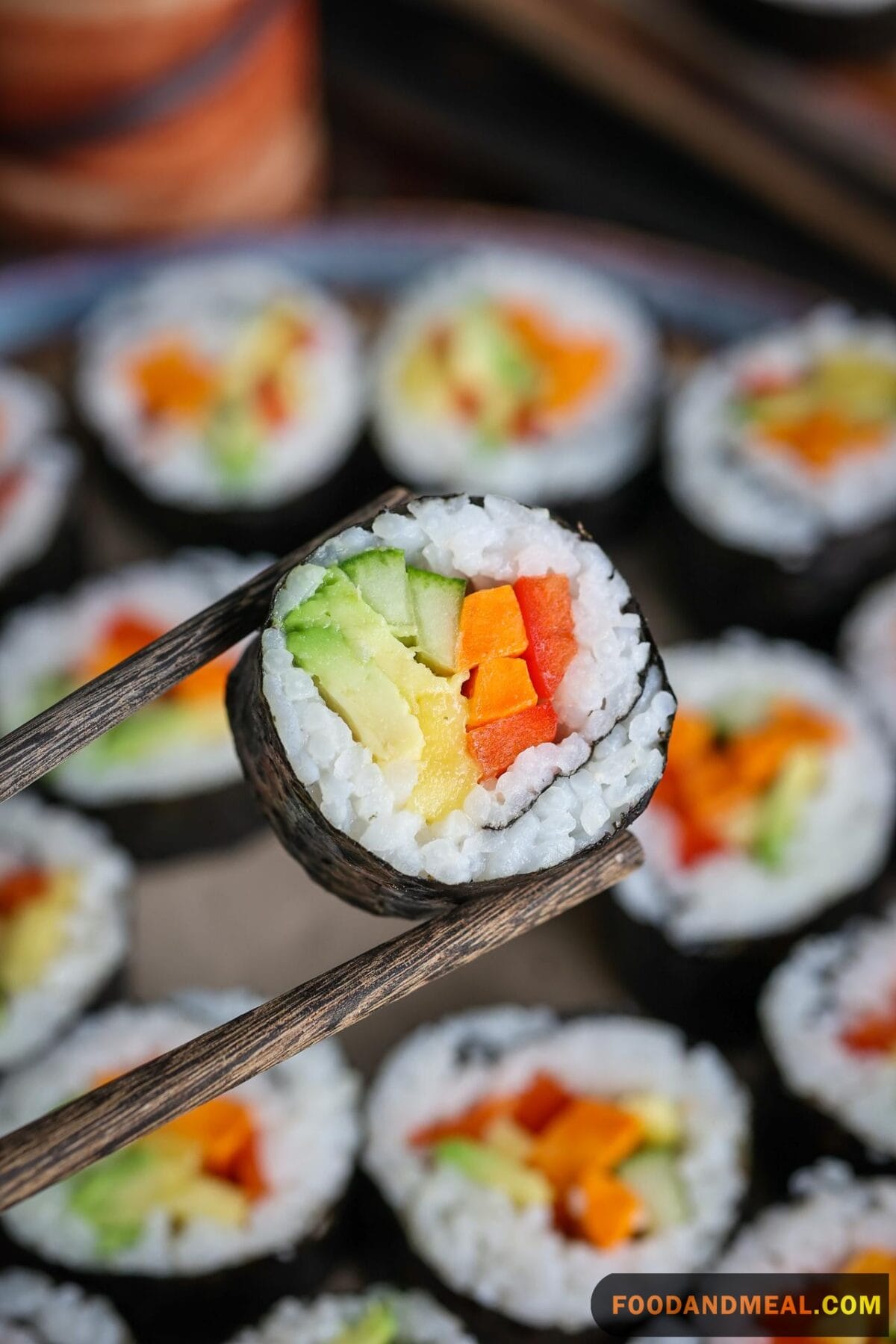
Ingredients:
- 2 cups sushi rice
- 1/4 cup rice vinegar
- 2 tablespoons sugar
- 1/2 teaspoon salt
- Assorted fresh vegetables (e.g., cucumber, carrot, avocado, bell peppers, and lettuce), thinly sliced or julienned
- Nori (seaweed) sheets, toasted and cut into strips
- Soy sauce
- Pickled ginger
- Wasabi
- Sesame seeds for garnish
Instructions:
- Prepare Sushi Rice: Rinse the sushi rice under cold water until the water runs clear. Cook the rice in a rice cooker following the manufacturer’s instructions. While it’s hot, transfer it to a large bowl.
- Season the Rice: In a small saucepan, combine the rice vinegar, sugar, and salt. Heat over low heat, stirring until the sugar and salt dissolve. Pour this seasoned vinegar mixture over the cooked rice and gently fold it in. Allow the rice to cool to room temperature.
- Assemble the Salad Bowl: In a serving bowl, place a generous portion of seasoned sushi rice. Arrange the sliced vegetables, toasted nori strips, pickled ginger, and wasabi on top.
- Drizzle with Soy Sauce: Just before serving, drizzle soy sauce over the vegetables and rice. You can adjust the amount to suit your taste.
- Garnish and Enjoy: Sprinkle sesame seeds over the salad bowl for added texture and flavor. Enjoy your Vegetable Maki Salad Bowl with chopsticks or a fork.
Tips for making Vegetable Maki

Serving Suggestions
Vegetable maki rolls make for a light and refreshing appetizer or side dish. I like to cut them into bite-sized pieces and arrange them beautifully on a platter, garnished with shredded carrots, sliced avocado, and a drizzle of ponzu sauce or wasabi dressing.
They also pair nicely with a variety of Asian-inspired soups and salads. For a complete meal, try serving the maki rolls alongside miso soup, a green salad with ginger dressing, and some steamed rice cooked by rice cooker from japan.
The sushi rolls can be customized in endless ways, so feel free to substitute your favorite vegetables or play around with different proteins. Thinly sliced pan-seared tuna or salmon maki rolls would be delicious, and the vegetables could be swapped for fresh mango, cucumber, or sweet potato. The possibilities are endless!
I hope these serving suggestions have sparked some creativity. Vegetable maki rolls are so versatile – they make easy finger foods for parties, healthy lunch box additions or even a sophisticated starter for date night. However you choose to enjoy them, their vibrant colors and flavors are sure to brighten any meal.
Cooking Tips
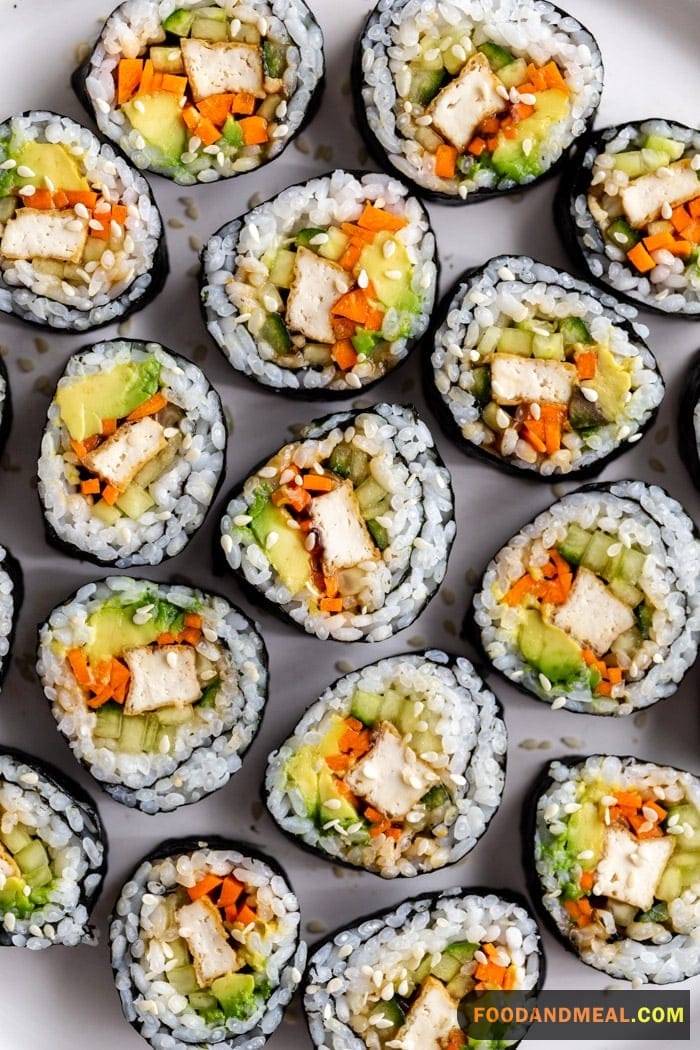
- Crispy Nori: To achieve the perfect crunch in your salad bowl, make sure to toast the nori sheets briefly before cutting them into strips. This step adds a delightful texture.
- Proper Seasoning: Season your rice thoroughly but with restraint. Over-seasoning can overpower the fresh vegetable flavors, so taste as you go.
- Freshness Matters: Use the freshest vegetables you can find. The success of your salad bowl depends on the quality and vibrancy of your ingredients.
- Chilled Ingredients: Keep your vegetables cool before assembling your salad. This maintains their crispness and ensures a refreshing experience.
- Customization: Encourage customization. Let each diner tailor their Vegetable Maki Salad Bowl to their liking, providing a personalized sushi adventure.
8 FAQs about Vegetable Maki
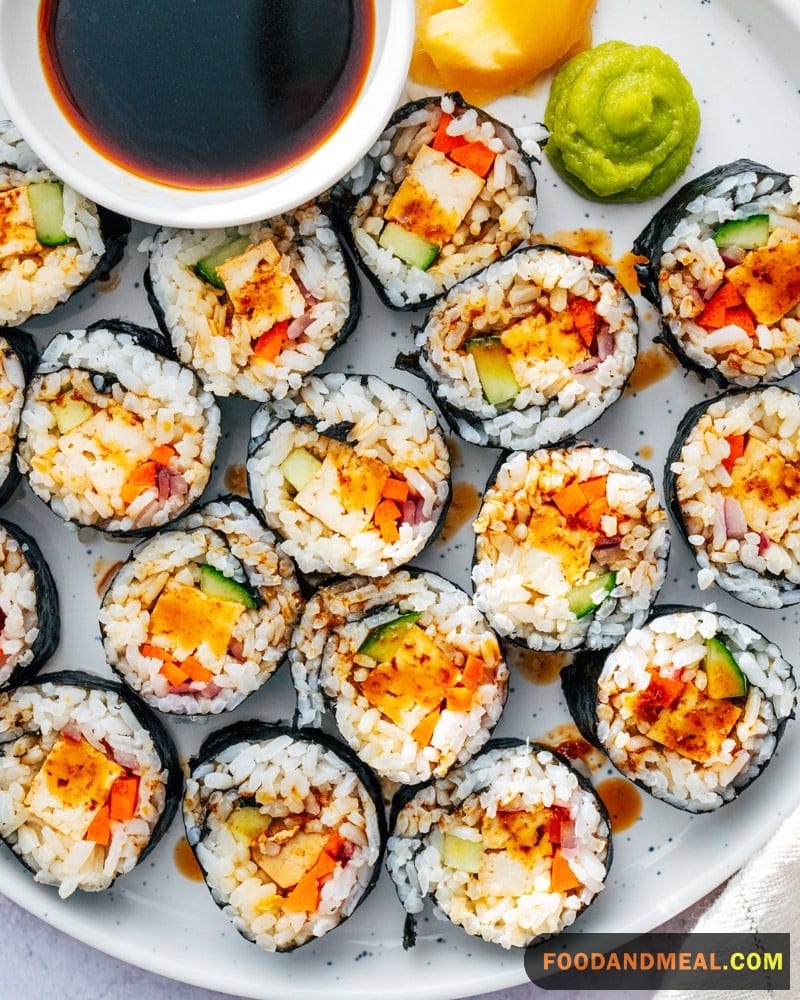
- What are maki rolls made of?Maki rolls typically consist of sushi rice, seaweed (nori sheet), and a variety of fillings such as raw or cooked fish, vegetables, and sometimes avocado. They are rolled together using a bamboo mat and then sliced into bite-sized pieces.
- What is the difference between maki and sushi roll?The terms “maki” and “sushi roll” are often used interchangeably, but technically, all maki are sushi rolls. “Maki” refers to rolled sushi, which comes in different types such as hosomaki (with rice on the inside and seaweed on the outside), uramaki (with rice on the outside), and temaki (hand rolls).
- What’s a vegetable sushi roll called?A vegetable sushi roll is commonly referred to as a “vegetarian maki” or “vegetable maki.” These rolls are made with a variety of fresh vegetables, and sometimes include avocado or tofu as a protein substitute.
- Can I prepare the sushi rice in advance for the salad bowl?Yes, you can cook and season the sushi rice in advance. Just make sure to cool it to room temperature before assembling your salad to maintain the desired texture.
- Are there any alternative vegetables I can use in the salad bowl?Absolutely! You can get creative with your choices. Try incorporating radishes, spinach, asparagus, or any other fresh vegetables you enjoy to customize your salad bowl.
- Can I make the salad bowl vegan?Certainly! Ensure that your nori sheets and soy sauce are vegan-friendly, and omit any animal-based ingredients. Enhance the flavors with vegan mayo or a drizzle of sesame oil for a delicious vegan option.
- How do I store leftover Vegetable Maki Salad Bowl?To maintain freshness, store leftovers in an airtight container in the refrigerator. It’s recommended to enjoy them within 24 hours for the best quality.
- Can I use brown rice instead of sushi rice?Yes, you can use brown rice for a healthier twist. Keep in mind that brown rice has a slightly different texture and flavor compared to traditional sushi rice, but it can add a nutty and wholesome element to your salad bowl.
Conclution
As I reflect on my vegetable maki roll journey, a few key lessons stick out. First, never be afraid to branch out and try new cuisines – you never know what you might discover. While barbecue will always have my heart, I’m so glad I took a chance on delicate Japanese flavors.
Second, let your creativity run wild in the kitchen! There are endless combinations of fillings and sauces just waiting to become your next signature maki roll. I’ve had a blast dreaming up new veggie-packed rolls to satisfy my cravings.
And finally, sharing food is sharing joy. I can’t wait to keep whipping up veggie maki to enjoy with my family and friends. My hope is that these lighter, brighter rolls might inspire others to give their bodies a little TLC too.
Who knows – maybe these will even catch on enough that I can open my own little maki and barbecue fusion joint! Food And Meal’s Healthy Hog Rolls has a nice ring to it! But for now, you can find me in my home kitchen with grains of rice stuck to my fingers, nori wrappers overflowing with veggies, and a big smile on my face.
I'm James F Anderson, a noted sous chef from London and a Le Cordon Bleu alumnus. My career began in a Michelin-starred Parisian eatery, where my blend of classic and contemporary cooking, using seasonal ingredients, earned accolades. Recognized in culinary publications and on cooking shows, I’m committed to mentoring aspiring chefs and delivering memorable dining experiences, marking me as a standout talent in the culinary world.


